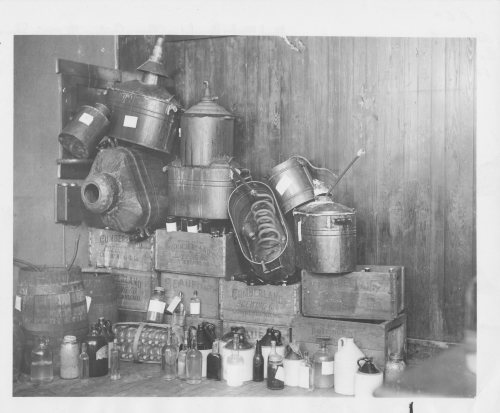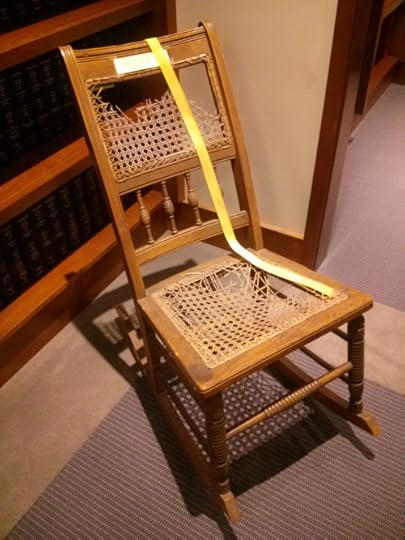James Rada Jr.'s Blog, page 28
January 25, 2014
The Goldsboro crash: the terrifying accidental doomsday that almost happened.
 Reblogged from www.seanmunger.com:
Reblogged from www.seanmunger.com:
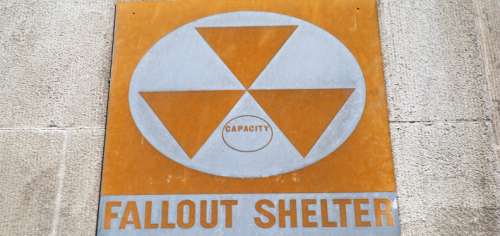

Today's date, January 24, was almost a day of tragedy in American history that would have ranked right up there, or even surpassed, December 7 and September 11. Fifty-three years ago today, on January 24, 1961, a U.S. Air Force B-52 fell out of the sky near Goldsboro, North Carolina. It happened to be carrying two nuclear weapons. They almost detonated.
Sean, there was a similar crash in Grantsville, Maryland, around the same time. It recently got some press because it was the 50th anniversary. If I remember right it was the same type of bomber and it was also carrying 2 nuclear warheads. I was working for the newspaper out that way some years back when they erected a memorial to the crash. The problem with the Maryland crash is that the wreckage was strewn over miles and the bombs were found in an isolated area of the Appalachian Mountains.
January 16, 2014
1931: Bootlegger vs. a revenue agent in Oldtown
The two revenue agents for the federal government crept into the woods around Oldtown on November 15, 1931. William R. Harvey was the senior agent so he led the raid. They were after three bootleggers who they had been watching lately.
While making illegal liquor during Prohibition was a problem in Western Maryland due to its abundance of forests and lack of population, it usually wasn’t a fatal one like it could be in the larger cities. For the most part, it was a game of hide and seek between the bootleggers who would try and hide their stills and federal agents who would try and find them. If a bootlegger was caught, he would serve a few months in prison and then start all over again when he got out.
Two of the bootleggers had been arrested previously for manufacturing illegal liquor. Now they would be arrested again.
Harvey and the other agent hurried into the clearing with their weapons drawn. One of the men nearest the woods dashed away, but it wasn’t like Harvey didn’t know who the men were. The two remaining men were John Ralph Davis and Emmett Judy, both of Oldtown. They had been caught with a 50-gallon still, six barrels of mash and two gallons of rye whiskey.
“After the officers had handcuffed Davis and Judy, they were fired upon by an unseen assailant from the woods, the shot narrowly escaping both the officers and the prisoners,” the Cumberland Evening Times reported.
Harvey returned fire with his .45 pistol. The unknown shooter appeared further away up a hill firing a double-barreled shotgun, then he retreated back into the shelter of the woods. The gunfire exchange lasted for several minutes. Harvey fired 21 shots and the unknown attacker fired around 20 times. Since the agents had bound prisoners, they took cover and circled around their attacker in order to get the prisoners safely to the agents’ car.
The newspaper reported that the attacker with the shotgun “is believed to have been the lookout stationed near the still and when he saw the officers arresting the other bootleggers, opened fire in an effort to obtain their release.” He was also believed to have been drunk at the time of the shooting.
The third bootlegger, Lemuel Keifer, was arrested at his home near midnight on November 15. Lewis Davis was also arrested on November 16 as the man who had fired on the agents.
Oddly, the newspaper also made note of some of the agents’ investigative techniques, which undoubtedly gave bootleggers in the county food for thought. The Cumberland Evening Times said that many bootleggers were being arrested on Sunday because they let the stills be idle during the week and worked them on the weekends. “The bootleggers appear to believe that the officers work only during the week, but the large squad stationed here make it possible for men to be on the job at all times,” the newspaper reported.
When the case came to trial the following May, Davis was released because there were not enough proof that he was the attackers, but the three moonshiners were given sentences of 3 to 6 months in the county jail. Some served time in the Allegany County jail, but when it was too crowded, other prisoners would be taken to the Garrett County jail in Oakland.


January 10, 2014
1790: Was the Snider family massacred on Catoctin Mountain?
 Jacob Snider, one of the early settlers in the area, owned 25 acres west of Owens Creek Campground on Catoctin Mountain that he obtained in 1770. The parcel, called “Snider’s Gardens” was “at a bounded white oak standing on the North side of a branch that runs into Owens Creek, about 20 perches (330 feet) from said creek,” according to the land deed.
Jacob Snider, one of the early settlers in the area, owned 25 acres west of Owens Creek Campground on Catoctin Mountain that he obtained in 1770. The parcel, called “Snider’s Gardens” was “at a bounded white oak standing on the North side of a branch that runs into Owens Creek, about 20 perches (330 feet) from said creek,” according to the land deed.
Further west, a settlement was established near the mouth of the Conococheague Creek. It could be reached from the Thurmont area by traveling the Monocacy Indian Path. The path ran from Wrightsville, Pa., to the Shenandoah Valley.
“Like most frontier outposts, the Conococheague Settlement was an occasional target for Indian raids. On one such occasion, a raiding party of Susquehannas captured a young Scotchman named Peter Williamson, and forced him to carry their loot. He later escaped, or was freed, and lived to a ripe old age,” Frank Mentzer, superintendent of Catoctin Mountain Park, wrote in the September 7, 1968, Catoctin Enterprise.
Mentzer made the case that the Jacob Snider family was massacred by Indians in the late 1700′s. He based his belief on an account written by Williamson called The Life and Curious Adventures of Peter Williamson, who was Carried Off from Aberdeen, and Sold for a Slave.
Though the book is inflammatory, which is understandable since it is written by a man who was probably angry about his treatment and seeking a way to vent his anger, it contains Williamson’s remembrances of his time with the Indians, including the massacre of the Snider family.
The Joseph Snider family in Williamson’s account lived in the Blue Hills area of the Appalachian Mountains. Snider, his wife, five children and a servant lived in the house.
Williamson and his captors approached the house. “They soon got admittance into the unfortunate man’s house where they immediately without the least remorse and with more than brutal cruelty scalped the tender parents and the unhappy children: nor could the tears the shrieks or cries of these unhappy victims prevent their horrid massacre for having thus scalped them and plundered the house of every thing that was moveable they set fire to the same where the poor creatures met their final doom,” Williamson wrote.
The Indians watched the house burn “rejoicing and echoing back in their diabolical manner the piercing cries heart rending groans and paternal and affectionate soothings which issued from this most horrid sacrifice of an innocent family,” according to Williamson.
Mentzer noted in his account that Snider’s Gardens was located not too far off the Monocacy Indian Path so it would not have been unheard of for Indians to pass near the homestead. He also pointed out that while the Joseph Snider family lived near the Blue Hills, Snider’s Gardens was just south of an area known as Blue Mountain.
Williamson notes in his account that the Blue Hills were 30 miles from the Conocheague Creek. This is the same distance that Snider’s Gardens is from the creek.
Mentzer believed that the small differences that Williamson wrote down can be accounted for by the time between when he experienced things and when he was finally able to write about his captivity.
“It is possible that Jacob and his family lived long and prosperous lives in their ‘Garden’ on Catoctin Mountain,” Mentzer wrote. “It is also possible that they were scalped by a warring party of Susquehanna Indians and consumed in the fire of their burning home.”


January 7, 2014
The Turk: the incredible story of the amazing 18th-century chess-playing robot.
 Reblogged from www.seanmunger.com:
Reblogged from www.seanmunger.com:
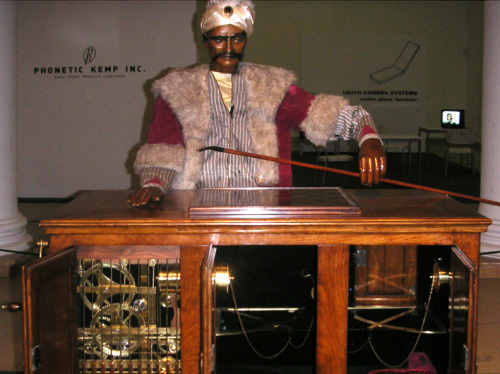


In 1770, Wolfgang von Kempelen, a Hungarian-born inventor who was something of the "Doc Brown" of 18th century Europe, unveiled an amazing new machine at the court of Austrian Empress Maria Teresa: the Automaton, or "Turk," a mechanical robot that could beat human opponents at chess. The robot was a half-figure of a man, dressed in Turkish costume and wearing a turban, embedded in a large wooden box which contained the gears and mechanism that operated it, the top of which was the chess board.
December 23, 2013
Brotherhood of the Jungle Cock (and, no, this isn’t porn…it’s history!)
 On May 23, 1953, about 350 boys and probably just as many adults gathered on the banks of Hunting Creek where the Thurmont (Md.) Town Office now sits. The boys were at the end of a three-day campout where they were taught how to fly fish.
On May 23, 1953, about 350 boys and probably just as many adults gathered on the banks of Hunting Creek where the Thurmont (Md.) Town Office now sits. The boys were at the end of a three-day campout where they were taught how to fly fish.
The adults included men like U.S. Supreme Court Chief Justice William Douglas; U.S. Senators J. Glenn Beall, John M. Butler and A. Willis Roberterson; Congressman DeWitt S. Hyde and former Maryland Governor Preston Lane. They were there to dedicate a memorial to deceased members of the Brotherhood of the Jungle Cock.
While the name of the group sounds like the title to a bad porn movie, Ken Crawford, president of the Jungle Cocks at the time said in the Frederick Post, “Our only aim is to teach youngsters the art of fishing. … We just want to teach them to have more fun while fishing, to observe the rule of the sport, and to take a hand in the conservation of our fish, game and natural resources.”
Though the group had been founded in Thurmont in 1939, it had spread to other states.
“The concept of teaching youngsters about fishing and conservation of our natural resources was the ground work for the formation of the Brotherhood,” Thomas W. Cooney wrote in his article, “A History of the Brotherhood of the Jungle Cock.”
The group’s earliest roots can be traced to when Joseph W. Brooks, Jr., J. Hammond Brown and Frank Burt Smoot launched The Junior Outdoorsman. The Maryland State Game and Fish Protective Association published the magazine directed specifically at young boys.
Brooks was the chairman of the Fresh Water Committee of the Maryland State Game and Fish Protective Association and Brown was president of the association. Another founding member, Frank L. Bentz, Sr., was the public relations director of the Maryland Game and Inland Fish Commission.
Brooks and Brown encouraged Bentz to arrange a weekend outing on Big Hunting Creek. Invitations were mailed on the letterhead of The Maryland State Game and Fish Protective Association to association members and to the Outdoor Writers Association of America, as well as other guests, according to Cooney.
Twenty-five men attended that first outing on the opening day of trout season in 1939. They were so pleased with the event that they decided to continue it annually as “The Anglers Campfire.”
However, the next year, a late snow froze the anglers’ fishing lines and so they stayed in their cabins.
“As the men sat in the warmth of the lodge there was talk of fishing and the perpetuation of the sport, the environment, and the conservation of our natural heritage. It was decided that an organization be formed that would address the concerns of the group, and that the focus must be on tomorrow’s inheritors,” Cooney wrote.
On May 21, 1940, the anglers met again and voted to call their group, “The Brotherhood of the Jungle Cock”. The name refers to the male Asiatic Jungle Fowl, whose feather is highly sought after for fishing flies.
The monument, which was sculpted by William Carter Wescott, showed a man and boy in their fishing gear. The boy is grinning as he displays his trout that he caught on his fly rod. The man is stooping to release the fish from the boy’s line. The figures were cast in bronze and set on a 64-inch high base made of stones from Hunting Creek.
Douglas gave the dedicatory address at the ceremony and then presented the memorial to Crawford. Crawford, in turn, then presented the monument to Thurmont Mayor C. Ray Weddle, who accepted it on behalf of the town. The town had also donated the land where the monument was place.
The monument still greets visitors who park at the town office.


December 19, 2013
Ancient music or modern noise?
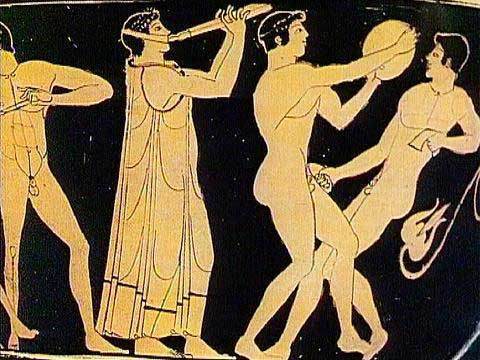 “Suppose that 2,500 years from now all that survived of the Beatles songs were a few of the lyrics, and all that remained of Mozart and Verdi’s operas were the words and not the music,” the BBC News reported recently.
“Suppose that 2,500 years from now all that survived of the Beatles songs were a few of the lyrics, and all that remained of Mozart and Verdi’s operas were the words and not the music,” the BBC News reported recently.
Have you ever thought about how the music of an ancient culture sounds? Would you be able to recognize it as music or would it sound like noise? I mean consider how un-musical one generation’s music sounds to an older generation. Does that difference get multiplied by a factor with each additional generation’s separation?
A musician and tutor at Oxford University, Armand D’Angour, believes he has been able to recreate the music of Ancient Greece, which is something that hasn’t been heard for thousands of years.
Besides reconstructing the music from historical clues, you would have to be able to build the instruments that were used to play the music.
D’Angour believes that the rhythm of the words used in the ancient songs mimics the rhythm of the original music.
“And now, new revelations about ancient Greek music have emerged from a few dozen ancient documents inscribed with a vocal notation devised around 450 BC, consisting of alphabetic letters and signs placed above the vowels of the Greek words,” the BBC notes.
The Greeks also worked out the mathematical ratios of musical intervals. That, along with the documents, has allowed D’Angour to reconstruct some of the music.
Recreating the instruments is simpler, though not without problems. Lyres, reed pipes and percussion instruments are described in ancient texts and can be seen in paintings and even archaeological remains.
In bringing the music back to life D’Angour has had to act as a historian. He has had to put aside modern beliefs of what constitutes music and approach this project with fresh ears.
Do you think he succeeded? Click on this link to the original BBC story and you can also play an audio clip of one of the songs that D’Angour recreated.


December 15, 2013
LOOKING BACK 1945: Lincoln’s chair reappears
Last week, I wrote about how the chair that Abraham Lincoln may have used using the Gettysburg Address ceremony disappeared from Gettysburg College. This week, the rest of the story….
For years, Gettysburg College had displayed a rocking chair believed to have been the one Abraham Lincoln used as he sat on the platform during the dedication of Soldiers’ National Cemetery where he delivered his Gettysburg Address.
At some point in the 1920′s, it disappeared from the collection. No one knew who had taken it or how and no big deal was made of its loss.
Then on April 7, 1945, the Gettysburg Times reported, “The little old rocking chair that Abraham Lincoln is reputed to have used on the platform in the National cemetery November 19, 1863, when he delivered his deathless Gettysburg Address, has come back to the sanctuary of the college campus after an absence of close to a quarter century.”
The reappearance of the chair was as mysterious as its disappearance and original appearance at the college.
In March, Dr. Henry W. A. Hanson, president of Gettysburg College, received an anonymous letter from Charleston, W. Va., that alerted him that the chair was in Charleston and being offered for sale as a historical object.
The college’s lawyer, Richard A. Brown, wrote back to a resident of the city and received a reply from someone who admitted that they had possession of the chair and offered to return it to the college.
“A few days after the letter was received, the carefully wrapped and crated cane-seated rocker arrived at Mr. Brown’s office. From there it was sent to the college campus,” the Gettysburg Times reported.
Who had the chair, how it made its way to West Virginia and the price it would have fetched on the market still remain unknown today. Librarians with Special Collections staff have looked through the papers of the college’s past presidents seeking some clue, but have so far found nothing to authenticate the chair.
So the rocking chair with its damaged cane seat and back and scratched wood sits on a wire frame in the college archives. A yellow ribbon is draped from the back to the seat to keep anyone else from sitting on it and a small card is taped to the back of it that reads, “This chair was reputedly used by President Lincoln during the dedicatory services of the Gettysburg National Military Cemetery.” This card, which has been on the chair since the college took possession of it, is the only record that the college has of the chair.
The college did not display the chair during the 150th anniversary of the Gettysburg Address.
“We currently have the rocker in storage in Special Collections and not on public display at this time. Without documentation, it would not be fair to display it since we cannot be certain of its provenance. There is plenty more research to be done,” said Carolyn Sautter, director of special collections and college archives at Gettysburg College.
The chair is protected in the college’s modern archive storage built in 2001. The Special Collections staff also continues to search out more information with the hopes that they will be able prove that not only is the chair the college currently owns the one that disappeared in the 1920′s but that it is also the one that Lincoln used in 1863.
If the chair is ever authenticated, it will then be prepared for display such as removing the card and preparing a plaque describing it. Until then, it remains in a historical limbo.
With so many mysteries surrounding the college’s early collections, it would be great to be able to solve this one and affirm the chair as a piece of American history.


December 6, 2013
LOOKING BACK 1920′s: Lincoln’s chair vanishes
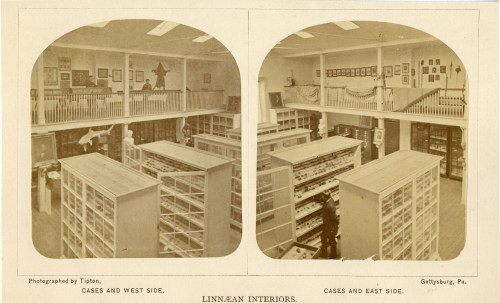
Linnaean Hall. Courtesy of Special Collections/Musselman Library, Gettysburg College.
On November 19, 1863, thousands of people gathered in Gettysburg for the dedication of Soldiers’ National Cemetery. The keynote speaker of the event was Edward Everett. As his speech continued on and on, people standing in the crowd had to sit or risk their legs buckling. On the stage, the speakers had chairs to rest on until their time to speak came.
President Abraham Lincoln sat in a rocking chair between Everett and Secretary of State William Seward.
“Mr. Lincoln sat on the platform all the time in a rude, little stiff-backed chair, hard, and uncomfortable, but he hardly ever moved,” Dr. Henry Jacobs recalled in the Gettysburg Times in 1923. He had been a young boy in the audience at the dedication.
When Everett had finished his two-hour speech, the president stood up from his rocker, walked to the podium and delivered 286 words that we still recall today as one of the great speeches of American history.
Today, you can see the chair that President Abraham Lincoln was sitting in when he was killed. You can see the chair he sat in while writing portions of his Gettysburg Address, but as we approach the 150th anniversary of the Gettysburg Address, whatever happened to the rocking chair Lincoln sat on during the dedication ceremony?
That’s a tricky question.
Gettysburg College owns it…maybe.
In 1847, Gettysburg College (then Pennsylvania College) students built Linnaean Hall, primarily as a place to display their rock and mineral collections. Over the years, other collections were placed on display in the hall. At first, they were all scientific featuring shells, plants and animals. Then they became historical.
“Miscellaneous collections included coins, Indian relics; natural curiosities, battlefield memorials, and the like. A few stray items such as an ivory cane used by Abraham Lincoln, and a paper signed by George Washington, have also been found,” The Gettysburgian reported in 1937.
One of those “stray” items was apparently an armless, cane-backed rocking chair that is supposed to have been the one that Lincoln sat upon during the dedication ceremony for Soldiers’ National Cemetery. The problem was there is no record as to where the chair came from. The records may have been lost, damaged or never existed at all. The college did not have the controls that it does now.
This can be seen in the fact that Linnaean Hall had no security for its collections. “The building was open to visitors at all times, and as a result people finally began to steal the valuable collections,” The Gettysburgian reported in 1937.
The Lincoln chair was apparently a victim of such a theft. When it disappeared from Linnaean Hall in the early 1920′s, “No public ado” was made of it, according to the Gettysburg Times in 1945.
“College officials knew the chair had disappeared but there was nothing to indicate its whereabouts—and little reason to hope that it might ever be recovered,” the Gettysburg Times reported.
Linnaean Hall was demolished in 1942 and what remained of the exhibits were moved to the east end of the third floor of Glatfelter Hall, at least the collections that were still around.
“Since there was no place to store the large rock and mineral collections, and geology was taught no longer, they were hauled to a local dump and deposited. As a footnote to this travesty, the October 1, 1942 issue of the Gettysburg Times would note that ‘The accumulation of junk has been removed, the pigeons and squirrels have found new abodes, the students have no more windows to smash, the Owl and Nightingale Club has no place for its sign, and Joe the Janitor has several hundred square feet more lawn to mow,’” Jay Lininger wrote in his article “Chronicles of Central Pennsylvania Mineralogy” on Pennminerals.com in 1998.
A part of the college’s history had been lost, but as the saying goes, “History repeats itself.” So it would be with Gettysburg College as the chair that had mysteriously appeared as part of its collections and then disappeared would again just as mysteriously reappear.


November 20, 2013
Living near the entrance to Hell
 The story of Centralia, PA, has always amazed me. I wonder if anyone has written a book about it. It’s hard for me to imagine that a fire has been burning underground for more than 50 years.
The story of Centralia, PA, has always amazed me. I wonder if anyone has written a book about it. It’s hard for me to imagine that a fire has been burning underground for more than 50 years.
Centralia was a coal-mining town in Pennsylvania. In 1962, a fire started in one of the mine shafts and spread throughout the network of shafts of under the town. Since it was a coal mine, the fire found plenty of fuel. If that wasn’t bad enough, the residents had to deal with poisonous gases leaking out of the mines and sinkholes appearing.
Yahoo News reported, “The mine fire has transformed Centralia into a macabre tourist attraction. There’s an intact street grid with almost nothing on it, clouds of steam waft from the cracked earth, and visitors gawk at the ruins of an abandoned highway.”
The federal government started a relocation program and by the 1990, more than a 1,000 people had moved away and 500 buildings razed. After all, who wants to live in a town that looks like it is the entrance to Hell?
Apparently there were people who wanted to live there, though. Eight residents recently settled their lawsuit against Pennsylvania that was filed when the state tried to evict them. They can stay as long as they want and they get $349,500.
Congratulations to them on winning their case, but given where they live, I think it’s a bit of a hollow victory.
Here’s the link to the Yahoo News story.


November 15, 2013
1833: The night the sky fell in Gettysburg
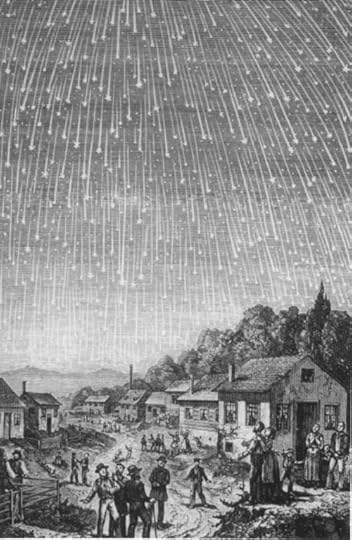 The old Adams County jail wasn’t the most secure of prisons. Early in the morning of November 12, 1833, a convicted murderer was so scared that he broke out of the prison, according to the History of Adams County published in 1886. Though the man was free from prison, he still wore shackles. He ran to the nearest blacksmith shop and filed them off. Then, “as he forgot to come back and give himself up to be hanged, it may be inferred he is still fleeing from the ‘stars’ that do not pursue,” according to the History of Adams County.
The old Adams County jail wasn’t the most secure of prisons. Early in the morning of November 12, 1833, a convicted murderer was so scared that he broke out of the prison, according to the History of Adams County published in 1886. Though the man was free from prison, he still wore shackles. He ran to the nearest blacksmith shop and filed them off. Then, “as he forgot to come back and give himself up to be hanged, it may be inferred he is still fleeing from the ‘stars’ that do not pursue,” according to the History of Adams County.
Few people probably even noticed the killer’s escape that evening. Their eyes were turned to the heavens watching the reason the man had become scared enough to break out.
“The whole heavens appeared to be illuminated by countless meteors, of different sizes, which darted frequently horizontally, leaving long trains, but generally fell silently to the ground, resembling, as some term it, large flakes of snow, or as if it were ‘snowing stars,’ the Gettysburg Compiler reported.
Many people reported beginning to see the falling stars around dusk the day before but the peak of activity seems to have been in the hours before dawn on the 12th. The Gettysburg Compiler called it “one of the most splendid and awful spectacles the mind can conceive of, was witnessed in the heavens.”
The murderer wasn’t the only one fearing the stars that morning. The Carlisle Volunteer noted that the sight of thousands of fiery trails in the sky started people predicting all sorts of dire consequences. “One remarked it was occasioned by the removal of Deposites from the U.S. Bank!—another, that there would be a division of the Union!!—and a third, that it was a sure sign of the rapid approach of cold weather!!!” the newspaper reported.
It wasn’t a prediction of the Apocolypse, though. The meteor shower was the Leonid Meteor Shower. It is caused in part by the comet Tempel-Tuttle, which had yet to be discovered in 1833. The comet passes the Earth every 33 years and around mid-November of the year that it passes, the Earth moves through the stream of particles and debris that the comet leaves behind.
The 1833 meteor shower was one of the more spectacular ones seen throughout America east of the Rocky Mountains. Many newspapers reported on the event.
The Gettysburg Compiler described it this way: “To form some idea of the phenomenon, the reader may imagine a constant succession of the fire balls, resembling sky rockets, radiating in all directions from a point in the heavens near the zenith, and following the arch of the sky towards the horizon. They proceeded to various distances from the radiating point, leaving after them a vivid streak of light, and usually exploding before they disappeared. The balls were of various sizes and degrees of splendor. The flashes of light, though less intense than lightning, were so bright as to awaken many people in their beds, and many were alarmed, and astonished every person who beheld it.”
The variation in intensity comes from slight variations in the path and size of the dust cloud. The deeper the earth enters it the more spectacular the meteor shower. Other big years for the meteor shower were in 1866 and 1965. No meteors were seen in 1899, which started speculation that the meteor had changed its path. However it returned again in 1932.



